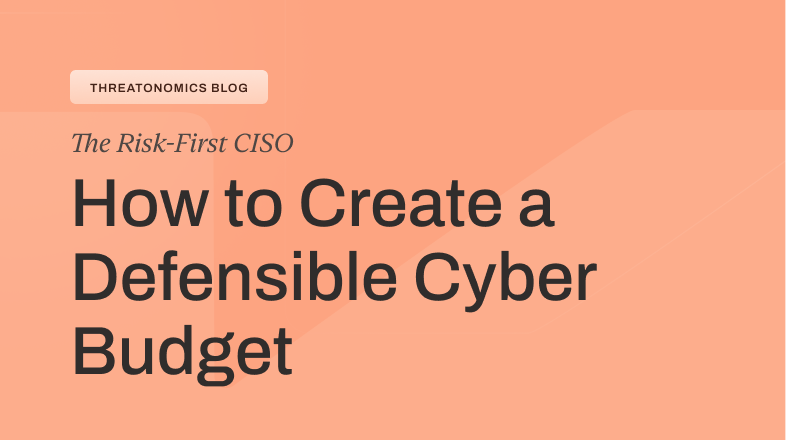Welcome back to the Resilience third-party management series. In our first three posts, we covered why third-party vendor discovery matters, how to locate vendors across your environment, and which high-risk vendor categories most organizations overlook. Now we turn to the next step: prioritizing those vendors based on actual cyber risk—not contract spend.
Most vendor management programs still treat financial spend as the primary indicator of vendor importance. A million-dollar contract triggers intensive scrutiny, while a $50-per-month SaaS platform quietly processing customer data gets little attention. This creates a massive mismatch between perceived vendor importance and actual vendor risk.
“Organizations often get hung up on how much they spend with a vendor,” says Resilience Senior Technical Security Advisor Chuck Norton. “But spend isn’t risk. What really matters is the data a vendor stores and how their services map back to your business processes.” A modern vendor-tiering model must reflect data exposure, business criticality, and operational dependencies—not contract value.
Why spend-based tiering fails
Spend-based tiering assumes financial value correlates with risk, but in reality, cyber risk is driven by data sensitivity and business impact. Small, inexpensive vendors often hold critical data or play an outsized role in operations, while high-spend contracts may have minimal access to systems or information. This mismatch leaves organizations blind to real exposure.
The small-vendor, big-risk problem emerges when low-cost tools—authentication services, backup utilities, free analytics platforms—handle sensitive information or perform vital functions yet receive little scrutiny. A $500/month identity tool storing all employee login credentials likely poses more cyber risk than a six-figure design contract. Traditional tiering puts these vendors at the bottom, when they should be near the top.
The reverse scenario demonstrates why spend is a poor proxy for cyber risk. High-spend relationships like office furniture suppliers or landscaping vendors often have minimal system access and limited operational impact. Their financial importance doesn’t translate into cyber exposure, and treating them as high-risk vendors wastes assessment resources and slows down procurement cycles.
A four-metric approach to data risk
To evaluate vendor risk accurately, programs must begin with data. Norton recommends assessing vendors based on the sensitivity and volume of the information they handle, grouping data into four primary categories. This approach creates a measurable, repeatable method for determining which vendors truly matter.
Personally identifiable information (PII) includes records such as names, addresses, SSNs, financial accounts, and employment history. Vendors handling large volumes of PII can trigger severe regulatory exposure if compromised. Protected health information (PHI) adds another layer of sensitivity for healthcare and adjacent industries, covering medical records, insurance details, and health-related identifiers.
Payment card industry (PCI) data introduces strict compliance requirements and demands heightened oversight for any vendor involved in payment processing workflows. Finally, general user and operational data—behavioral analytics, application logs, system metadata, or intellectual property—may seem less sensitive but can still enable account takeover, privilege escalation, or competitive harm when mishandled.
Business process mapping for operational criticality
While data sensitivity determines what a vendor could expose, business process mapping determines what a vendor could break. Understanding how vendor services power your operations reveals the real-world impact of an outage, breach, or operational failure.
Norton explains the methodology: “You have a service portfolio of everything your organization delivers. Map vendors to those services. If revenue collection, issuing checks, or admitting students is critical, identify which vendors support those functions, then tier accordingly.” This creates a holistic view of operational dependency—not just technical access.
The process begins with identifying core business functions such as revenue generation, customer service, operations, compliance, and infrastructure. Once these functions are documented, vendors can be categorized based on whether they play a primary, supporting, or backup role in those processes. The final step is assessing business impact across dimensions like revenue loss, regulatory risk, customer disruption, and recovery time.
A practical three-tier framework
A vendor-tiering model should be simple enough for teams to apply consistently, but structured enough to reflect meaningful differences in risk. Most organizations benefit from a three-tier system that creates clarity around which vendors require deep scrutiny and which need only basic oversight.
Tier 1: Critical vendors
Criteria: Vendors that support mission-critical processes or handle sensitive data at scale. Failure would trigger material business impact or regulatory requirements.
Examples:
- Primary cloud infrastructure providers
- ERP, CRM, and billing systems
- Identity and authentication services
- Payment processors
- Primary data backup and recovery services
Requirements: - Full security assessments with annual updates
- SOC 2 Type II or equivalent certifications
- Continuous security monitoring
- Incident-response integration
- Documented business continuity planning
- Executive-level relationship management
Tier 2: Important vendors
Criteria: Vendors that support important processes or handle limited sensitive data. Failure would cause operational disruption but not existential risk.
Examples:
- Secondary business applications
- Collaboration and communication tools
- Marketing and analytics platforms
- HR systems
- Development and testing environments
Requirements: - Annual security assessments
- SOC 2 or equivalent certifications
- Quarterly business reviews
- Standard contractual security clauses
- Documented offboarding procedures
Tier 3: Standard vendors
Criteria: Vendors with minimal data exposure and limited integration with business-critical processes.
Examples:
- Office supplies and equipment
- Facilities and maintenance services without system access
- Training and professional development providers
- Marketing agencies without access to sensitive data
Requirements: - Basic security questionnaires
- Standard contractual terms
- Annual contract reviews
- Basic vendor verification
Advanced factors that refine your tiering
Even with a strong baseline model, certain characteristics can elevate or reduce a vendor’s overall risk. Incorporating these advanced factors ensures that your tiering reflects the realities of complex vendor ecosystems rather than relying solely on data volume or business dependency.
Geographic and regulatory considerations require special attention when vendors store or process data across borders or operate under compliance frameworks like HIPAA, PCI DSS, SOX, or ITAR. Integration complexity also adds risk when vendors have API access, SSO integration, administrative privileges, or VPN connectivity.
Vendor maturity and stability further influence risk. Startups with unstable finances, vendors lacking a mature security program, or those with limited sector experience may require increased oversight. Certifications, customer references, and audited security controls help validate vendor trustworthiness.
Implementing dynamic tiering
A tiering model is only effective if it remains accurate over time. Because vendor risk evolves with business changes, system updates, new integrations, and emerging threats, dynamic reassessment is essential. This ensures that your classification remains aligned with current exposure instead of outdated assumptions.
Reassessment may be triggered by scope changes, new data flows, additional business processes, or expanded user populations. Security incidents at a vendor or their subprocessors also warrant review. Automation can streamline this work through data classification tools, CMDB relationships, quantitative risk scoring models, and continuous security monitoring platforms.
Making tiering practical
Vendor tiering succeeds when it is both precise and operationally sustainable. Organizations should begin with the most obvious Tier 1 and Tier 3 classifications, then refine their model as they gain visibility into data flows and vendor dependencies. Early wins often come from clarifying which vendors truly require deep assessments and reducing unnecessary scrutiny elsewhere.
Cross-functional collaboration is critical. Business process owners provide essential insight into operational criticality and help prevent misclassification. Real-world incidents, such as unexpected outages or vendor breaches, should influence updates to the tiering model and highlight hidden risks.








